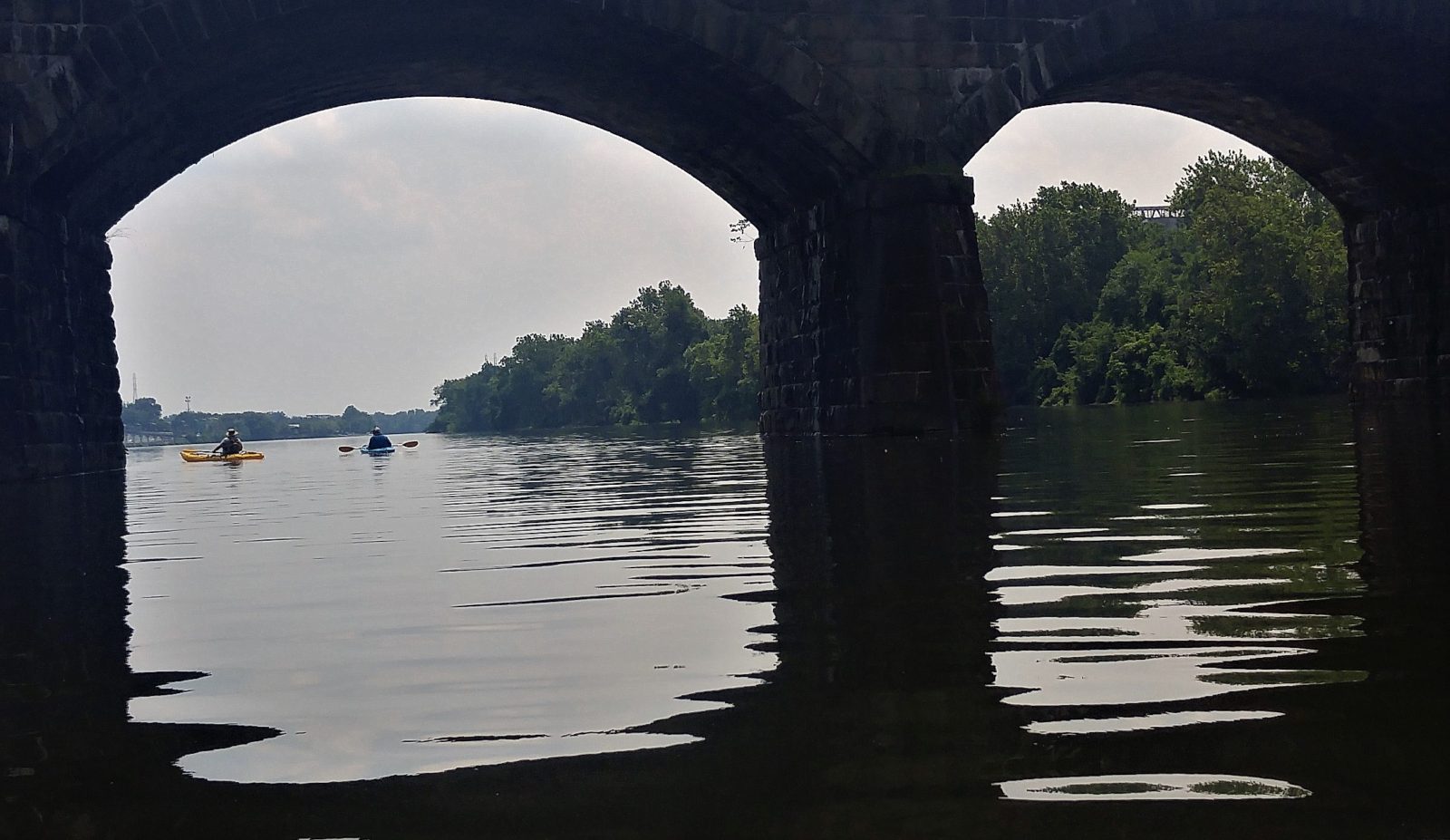If you have stamina, a voyage between 2017
and 1683 is within your reach. Come with us.
My job on arrival from Florida in the 1970s was to cover Falls Township for the Bucks County Courier Times. My first question to town officials: “Where are the falls? I’ve been looking for them.” I had enjoyed water sports including kayaking the Class IV rapids of the Crystal Stanislaus River in the Sierra Mountains of California. So I wanted to scope out Falls’ falls on the mighty Delaware. “Ah, it’s not in Falls,” the town manager replied. “It’s in Morrisville.”
After a few blink blinks, I set out for Morrisville and found the “Falls of the Delaware” between the borough and Trenton. Not much to see from the lofty dike in Morrisville. Rocky crags, a bit of a splash. But it was here in Colonial times that sailing ships could go no further upstream.

Recently Mark Bogdan suggested our kayak rat pack experience the falls on a 10-mile paddle down the Delaware from Lower Makefield to Quaker Penn Park in Falls. The park is adjacent to the mansion William Penn built. In my mind such an outing would trace three centuries of history – from the modern buildings and riverside expressway of 2017’s Trenton to the place Penn ruled Pennsylvania in 1683.
Mark, Tom Toth, Eric Baum and I rendezvoused before noon on River Road just above the falls. There we pushed off at high tide. The water is deeper at the falls when the Atlantic is pushing in from below Philadelphia 40 miles away. Those rocky crags become inundated, allowing a more-or-less carefree passage. We expected a voyage of about 4 hours. It turned into 6. The outgoing tide in such a wide estuary didn’t give us much of an assist. Buffeting winds from the south also required sustained paddling to keep from drifting backward.

Still, the breeze was a blessing in 97-degree heat. Plus the sights were interesting. After zipping through the falls, we passed under the four closely spaced bridges that link New Jersey’s state capital – where George Washington trounced the Hessians in 1776 – to Morrisville, home of Philadelphia banker Robert Morris who financed the American Revolution. The rush of the rapids bore us under the Calhoun Street iron bridge, a 1884 relic and part of Lincoln Highway, the nation’s first transcontinental thoroughfare. We passed beneath the Bridge Street bridge, the Route 1 toll bridge and the stone archways built in 1834 that today support Amtrack’s high speed rail line between Washington and Boston. We looked back to view “Trenton Makes The World Takes” lettering fastened in 1935 to the girders of the Bridge Street span.
Just downstream was Trenton Thunder’s minor league baseball park where Eric mimicked swatting a home run with his paddle from the river. Over the next few hours, we passed Trenton’s stunningly large power plant, a few marinas and Bordentown, N.J., the home of Thomas Paine who wrote incendiary essays that helped inspire the Revolutionary War. Deserted Newbold Island came next, once the planned site of a controversial nuclear power plant in the 1960s. En route, occasional carp splashed the surface. Hawks and a golden eagle swooped overhead. Only the whine of a few pleasure boats and the distant hum of traffic on I-295 disturbed the solitude of the mostly tree lined estuary.
Five hours into our outing, the blast of a ship’s whistle echoed loudly. Coming into view was a freighter docked at the starkly barren former Fairless Works steel mill port of the 1960s. Just down river a line of high trees returned the scenery to its primitive form where Pennsbury Manor is tucked away. It’s really jarring how close the two are – the sleepy manor next door to the busy port with its talus cones of precious minerals piled high, a rising sanitary landfill in the background and ships at anchor with gantry cranes in motion.

Another 20 minutes of steady paddling brought us to a river’s edge stone stairway to ornamental gardens and a brick pathway William Penn followed to the front door of his two-story mansion. It was here that he held consultations with Native Americans and presided over the colony’s only witchcraft trial. A jury of 12 convicted two Swedish women of the “common fame” of being witchy by putting spells on cows but not practicing witchcraft. They were ordered to behave after their husbands paid a fine. Case dismissed.
Penn loved the natural life along the Delaware and commented, “It were Happy if we studied Nature more in natural Things; and acted according to Nature; whose rules are few, plain and most reasonable.” Happiness for us was resting our paddles at the nearby 21st century Quaker Penn Park and experiencing the joy of a cold beverage and Bengay muscle rub. Ahhh!
Carl LaVO, a retired Courier Times editor, can be reached at [email protected]. His new coffee table book“Bucks County Adventures” can be ordered online at his website, www.buckscountyadventures.org
Carl will appear Tuesday, Aug. 22 at 7:30 p.m. in Langhorne to discuss local history and his adventures. The event is hosted by the Langhorne Council of the Arts at the Historic Langhorne Association Museum and Library, 160 W. Maple Ave.

